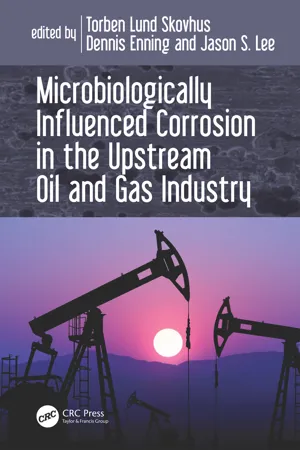
Microbiologically Influenced Corrosion in the Upstream Oil and Gas Industry
- 532 pages
- English
- ePUB (mobile friendly)
- Available on iOS & Android
Microbiologically Influenced Corrosion in the Upstream Oil and Gas Industry
About this book
Microorganisms are ubiquitously present in petroleum reservoirs and the facilities that produce them. Pipelines, vessels, and other equipment used in upstream oil and gas operations provide a vast and predominantly anoxic environment for microorganisms to thrive. The biggest technical challenge resulting from microbial activity in these engineered environments is the impact on materials integrity. Oilfield microorganisms can affect materials integrity profoundly through a multitude of elusive (bio)chemical mechanisms, collectively referred to as microbiologically influenced corrosion (MIC). MIC is estimated to account for 20 to 30% of all corrosion-related costs in the oil and gas industry.
This book is intended as a comprehensive reference for integrity engineers, production chemists, oilfield microbiologists, and scientists working in the field of petroleum microbiology or corrosion. Exhaustively researched by leaders from both industry and academia, this book discusses the latest technological and scientific advances as well as relevant case studies to convey to readers an understanding of MIC and its effective management.
Frequently asked questions
- Essential is ideal for learners and professionals who enjoy exploring a wide range of subjects. Access the Essential Library with 800,000+ trusted titles and best-sellers across business, personal growth, and the humanities. Includes unlimited reading time and Standard Read Aloud voice.
- Complete: Perfect for advanced learners and researchers needing full, unrestricted access. Unlock 1.4M+ books across hundreds of subjects, including academic and specialized titles. The Complete Plan also includes advanced features like Premium Read Aloud and Research Assistant.
Please note we cannot support devices running on iOS 13 and Android 7 or earlier. Learn more about using the app.
Information
Section IV Field Cases and Laboratory Studies
15 MIC under Conditions of Oxygen or Nitrate Ingress
15.1 Introduction
Table of contents
- Cover
- Half Title Page
- Title Page
- Copyright Page
- Contents
- Foreword by Anthony F. Mitchell
- Foreword by Gerrit Voordouw
- In Memory of Jan Larsen (1955–2015)
- In Memory of Hector A. Videla (1938–2012)
- Preface
- Editors
- Contributors
- Section I Materials and Corrosion in Oil and Gas Production
- Section II Microbiologically Influenced Corrosion Fundamentals: Microorganisms and Mechanisms
- Section III Microbiologically Influenced Corrosion Management
- Section IV Field Cases and Laboratory Studies
- Index


